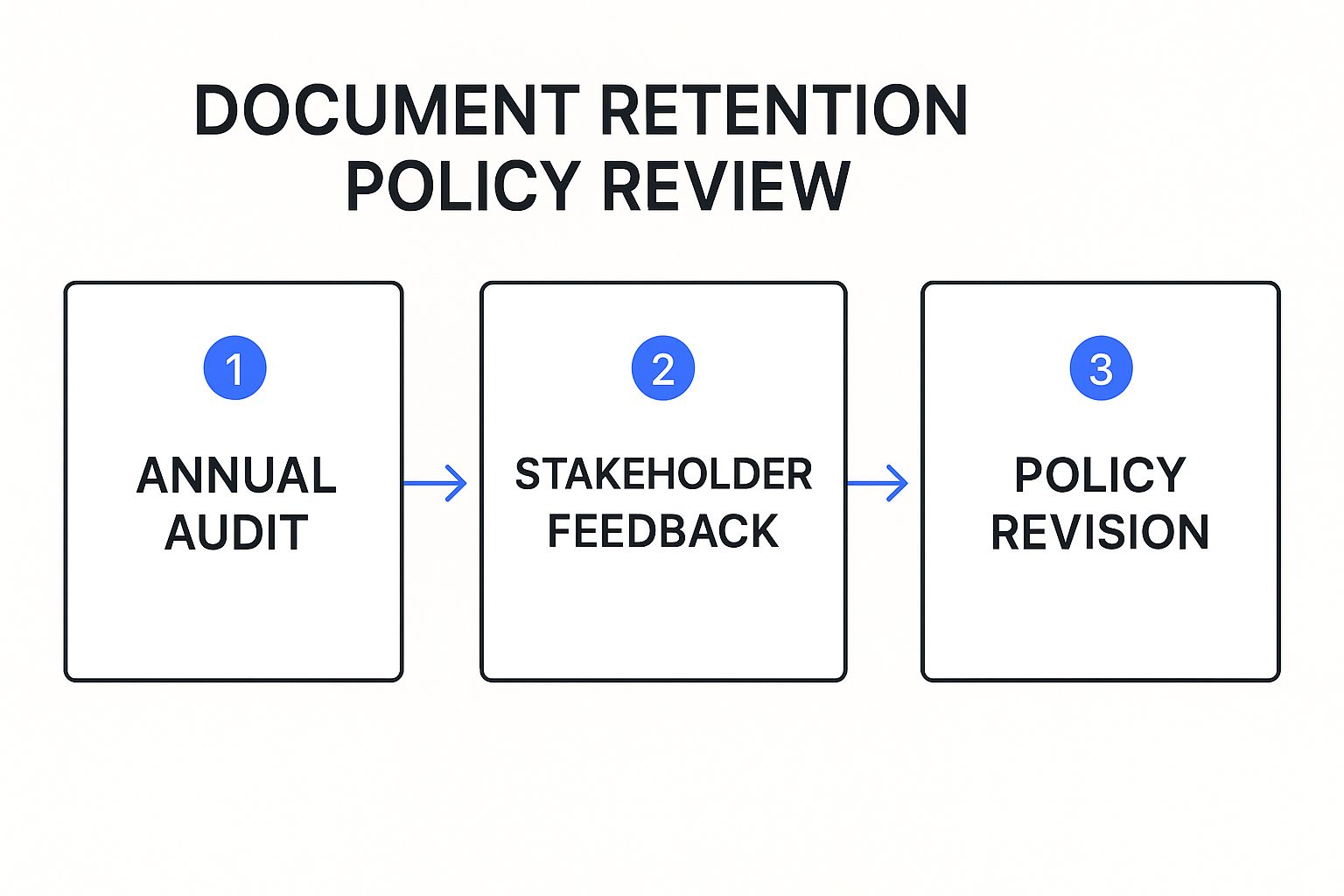
Making Sense of Document Retention Without the Confusion

Let's break down a term that sounds more complicated than it is. A document retention policy is simply your company's official set of rules for managing information. Think of it as a smart filing system that knows exactly what to keep, how long to store it, and when it’s finally okay to get rid of it. It’s like having a personal assistant who never loses an important file and always knows when an old receipt can be shredded. This system covers everything from paper contracts to digital files like emails.
While a document retention policy is essential for legal compliance, its real impact is felt in your daily operations. Business owners who implement a policy often describe a huge shift from chaotic, overflowing file cabinets (both physical and digital) to a more organized and efficient workplace. The goal is a system that works so quietly in the background that employees hardly notice it, all while keeping the business compliant and running smoothly.
From Legal Necessity to Business Advantage
The main point of a retention policy is to give your team clear, consistent instructions for handling documents from the moment they are created until they are disposed of. This isn't about hoarding every piece of data "just in case." Actually, it's the opposite. It’s about strategic disposal—knowing what you can and should delete to reduce clutter and risk. A good policy stops the accidental deletion of vital records while also preventing the buildup of old data that could become a liability.
For example, legal rules are always changing, with complex laws dictating how long certain records must be kept. In the United States, the healthcare industry is governed by HIPAA, which requires patient records to be held for a minimum of six years, and some states demand even longer periods. A well-designed policy turns these external legal requirements into simple, internal actions for your team. You can find out more about data retention laws around the world and how they differ by location.
Why a Clear Policy Matters to Your Team
Without a formal policy, your employees are left to make their own decisions about what to save and what to delete, which often leads to inconsistency and risk. One person might save every single email, while another clears their inbox every week. This creates an unreliable and messy information system. A formal document retention policy removes the guesswork by providing a single, clear guide.
It ensures that:
- Critical documents are protected and easy to find for audits, legal needs, or business operations.
- Old and redundant files are disposed of systematically, freeing up storage and reducing security risks.
- Everyone in the company understands their role in managing company records.
Ultimately, a strong policy supports your team by making compliance a straightforward and natural part of their daily work, not an extra chore.
Navigating Legal Requirements That Actually Matter

Tackling the legal side of a document retention policy can feel like you're trying to solve a puzzle with pieces from ten different boxes. The truth is, compliance isn't as scary as it looks, but it’s far more important than many businesses assume. The key is to recognize that legal requirements aren't a one-size-fits-all rule. What a financial firm needs to worry about is completely different from a small retail shop's obligations.
This is where the retention period—the exact amount of time you must keep a document—comes into play. It's the core instruction that gives your policy its legal strength. For instance, the Sarbanes-Oxley Act (SOX) requires public companies to keep audit records for seven years, while HIPAA mandates holding patient health information for at least six years. These aren't suggestions; they are legally binding rules with serious penalties for non-compliance. A solid policy translates these laws into clear, actionable steps for your team, removing confusion and risk.
Why Industry Context Is Everything
A common misstep is grabbing a generic template without thinking about industry-specific regulations. Imagine a chef and a pharmacist—both need to keep records, but their regulatory worlds are miles apart. A restaurant might focus on employee files and tax forms, while a pharmacy must track prescriptions and patient data with extreme precision under different laws. This is why a detailed document retention policy must be built for your specific operational environment.
The following table shows just how much retention periods can differ from one industry to another, highlighting why a customized approach is essential.
| Industry | Document Type | Minimum Retention Period | Key Regulation |
|---|---|---|---|
| Financial Services | Customer Communications & Trade Records | 6 years | FINRA Rule 4511 |
| Healthcare | Patient Health Information (PHI) | 6 years | HIPAA |
| Public Companies | Audit & Review Workpapers | 7 years | Sarbanes-Oxley Act (SOX) |
| Government Contracting | Project & Financial Records | 3 years post-final payment | Federal Acquisition Regulation (FAR) |
| Insurance | Employer Liability Insurance Policies | 40 years or permanently | Long-term claim exposure laws |
As you can see, simply following a generic "keep everything for seven years" rule could lead to major compliance gaps in some fields while creating unnecessary storage burdens in others. Understanding these specific requirements is the first step toward building a policy that truly protects your organization.
Turning Compliance into a Competitive Edge
Instead of seeing these rules as a burden, smart companies treat them as an opportunity. A strong document retention policy signals a commitment to responsible data management, which helps build trust with clients, partners, and regulators. When an audit or legal request happens, having your records organized and accessible proves your diligence and can shorten the investigation.
On the other hand, failing to produce required documents can lead to heavy fines, legal penalties, and significant damage to your reputation. By getting your policy right, you not only avoid trouble but also create a more organized, efficient, and trustworthy business.
Building Blocks of a Retention Policy That Works
Think of a document retention policy like a blueprint for a house. Without a solid plan, the structure can easily fall apart when tested. A good policy is more than just a formal document collecting dust on a shelf; it's a practical guide your team can actually follow. Its strength depends on three key pillars: clear retention schedules, defined disposal methods, and a solid understanding of compliance needs. If one of these is missing, your policy becomes a set of rules that looks good on paper but is ignored in practice.
This approach shifts the policy from being a list of rigid rules to a functional tool for your business. The focus moves from just what to keep to the more important how and why. The goal is to create a system that feels natural to your team, making compliance a simple part of their daily work instead of an extra chore.
Setting Clear Retention Schedules
At the core of any document retention policy is its retention schedule. This is the master list that clearly outlines how long to store different types of records. Imagine it as the instruction manual for your company’s storage room—it tells you that tax records need to stick around for years, while old project notes can be cleared out after a few months. To get this right, you first need to categorize your documents in a way that makes sense for your business.
Instead of complicated legal jargon, group your documents by how they are used:
- Employee Records: This includes items like employment contracts, performance reviews, payroll information, and termination forms.
- Financial Documents: Think tax returns, invoices, expense reports, and yearly financial statements.
- Customer & Contractual Files: This covers client agreements, project proposals, and signed contracts.
- Operational Records: This category includes internal memos, meeting notes, and project management files.
For each group, you'll set a specific retention period based on legal rules and your own business needs. For example, while standard financial records might need to be kept for seven years, employee contracts may need to be held for six years after an employee leaves. This level of detail removes any guesswork and empowers your team to act confidently.
Defining Disposal and Destruction Procedures
A policy that only tells you what to keep is only half the story. You also need a clear and secure process for what to do when a document’s retention period is over. This is a common blind spot for many businesses, often leading to keeping too much data and increasing risk. Your procedures should clearly explain how to destroy both physical and digital records, such as using professional shredding services for paper or certified data wiping for electronic files.
By establishing these end-of-life protocols, you ensure sensitive information is managed correctly, a key requirement of data protection laws like GDPR. Automating this process can be a huge help. To learn more about how technology can support these efforts, our guide on choosing the right legal document management system offers valuable insights. Defining these final steps makes your policy a complete, closed-loop system that protects your business from start to finish.
Why Your Current System Probably Isn't Working
 Many businesses operate with an unspoken rule: keep everything, just in case. While this approach might feel safe, it’s a quiet drain on your resources and a major source of risk. Think of your digital storage like a warehouse. Without an organization system, you just keep piling up boxes until it’s nearly impossible to find what you need. The result? You're buried in documents you don’t need while frantically searching for the ones you do. This reactive, "digital hoarder" mindset is why so many document management systems are broken.
Many businesses operate with an unspoken rule: keep everything, just in case. While this approach might feel safe, it’s a quiet drain on your resources and a major source of risk. Think of your digital storage like a warehouse. Without an organization system, you just keep piling up boxes until it’s nearly impossible to find what you need. The result? You're buried in documents you don’t need while frantically searching for the ones you do. This reactive, "digital hoarder" mindset is why so many document management systems are broken.
Good intentions can often lead to messy outcomes. You might believe that saving every email and file is a responsible way to preserve company history. In reality, this habit creates huge inefficiencies and legal weak spots. Imagine a legal request to produce specific contracts from five years ago. Sifting through terabytes of disorganized data isn't just time-consuming; it's a costly headache that can cripple your ability to respond. A formal document retention policy is what separates strategic information management from simple digital clutter.
The Hidden Costs of Keeping Everything
That "just in case" approach comes with real financial and operational consequences that are easy to ignore—until a crisis hits. The main problems include:
- Growing Storage Expenses: Cloud and server space aren’t free. Storing redundant, obsolete, and trivial (ROT) data eats up an ever-increasing slice of your IT budget.
- Lost Productivity: When employees waste hours digging for files, it directly cuts into the time they could spend on their main responsibilities. A 20% drop in productivity is a frequent estimate for companies with poor file management.
- Higher Compliance Risk: Keeping documents past their required retention period can be just as risky as deleting them too early. If a lawsuit arises, all retained documents—even expired ones—are subject to legal discovery.
This data buildup isn't just an internal issue. By 2025, the total amount of data worldwide is projected to reach an incredible 175 zettabytes. Yet, many companies can't manage this growth, with about a third of their data sitting untouched for over three years. What's more alarming is that 75% of these over-retained records contain sensitive information, opening the door to major security and compliance threats. You can explore more data privacy statistics to understand the full scope of this challenge.
Moving From Reactive to Strategic Management
Forward-thinking companies are moving away from reactive filing and toward proactive information governance. This involves creating a formal document retention policy that maps out the entire lifecycle of a document—from its creation and classification to its eventual, secure disposal. Putting a system like this in place isn't just about avoiding fines; it improves decision-making by making sure the data you use is relevant and trustworthy.
By setting clear rules, you give your team the confidence to manage information correctly. They will know what to save, where to store it, and for how long. This clarity turns your document management from a liability into a well-oiled asset. For more practical advice, take a look at our guide on the 8 best practices for legal document management. A strategic approach like this cuts overhead, reduces risk, and helps build a more resilient organization.
Your Practical Implementation Roadmap
A document retention policy is only as good as its execution. A perfectly written policy that isn’t put into practice is just a piece of paper. The real success lies in turning those well-defined rules into the daily habits of your team. This implementation roadmap breaks down the process into manageable phases, helping you bridge the gap between theory and action.
The journey starts with a comprehensive document audit. Think of this as taking inventory of your company's entire information warehouse—every digital file, every paper record, every email server. The goal is to understand what you have, where it is, and who owns it. This doesn't have to disrupt operations. You can assign department heads or "information champions" to lead the inventory process for their respective teams, creating a decentralized and more efficient audit. These champions will identify and categorize documents, mapping out the flow of information within their daily workflows.
Creating a System People Will Actually Use
Once you have a clear picture of your current state, the next step is to design a classification system and workflow that feel intuitive to your employees. A complex system with dozens of obscure categories will be ignored. Instead, build a simple, logical structure. For example, rather than using legalistic labels, use plain language that reflects how your team already thinks about their work, like "Client Contracts," "Active Projects," or "Financial Year-End Reports."
This practical approach extends to workflows. Instead of introducing a cumbersome, multi-step process for saving a file, integrate retention rules directly into the tools your team already uses. Modern document management systems can automate this by assigning retention periods based on the folder a document is saved to. For instance, saving a file in the "Signed Contracts 2024" folder could automatically trigger a seven-year retention rule without any extra effort from the employee. This makes compliance the path of least resistance.
Phasing the Rollout and Measuring Success
Trying to implement a new document retention policy across the entire organization overnight is a recipe for failure. A phased rollout minimizes disruption and allows you to learn and adjust as you go. Start with a single department or a specific document category as a pilot program. This allows you to work out any kinks in the process, gather feedback from a smaller group, and build a success story that encourages buy-in from other teams.
The following table provides a sample timeline for rolling out your policy, from initial planning to full implementation and review.
| Phase | Duration | Key Activities | Success Metrics |
|---|---|---|---|
| Phase 1: Planning & Discovery | 2-4 Weeks | - Assemble implementation team. - Conduct document audit. - Define policy scope and objectives. |
- Audit completed with 95% of departments covered. - Key stakeholders identified and engaged. |
| Phase 2: Policy & System Design | 3-5 Weeks | - Draft the document retention policy. - Design classification categories. - Configure document management system (DMS) workflows. |
- Policy draft approved by legal and management. - System configured with automated retention rules. |
| Phase 3: Pilot Program | 4-6 Weeks | - Select a pilot department. - Train pilot users on new system and policy. - Gather user feedback and identify issues. |
- 90% user adoption in pilot group. - Feedback collected and system adjustments made. |
| Phase 4: Full Rollout & Training | 6-8 Weeks | - Roll out the policy company-wide. - Conduct mandatory training sessions for all employees. - Provide support and resources. |
- 100% of employees complete training. - Measurable decrease in unclassified documents. |
| Phase 5: Ongoing Review | Continuous | - Schedule annual policy reviews. - Monitor compliance and system performance. - Update policy based on legal or business changes. |
- Successful completion of annual compliance audits. - Reduced storage costs by 15% or more. |
This timeline shows how a structured rollout can make the process manageable and set you up for long-term success.
To ensure your policy remains effective, it needs to be a living document, not a one-time project. This visual shows a simple, continuous improvement cycle for your policy.

This process flow highlights that policy management is an ongoing loop of auditing, gathering feedback, and refining the rules. Regular reviews ensure your policy adapts to new business needs and changing legal landscapes. Keeping track of these changes is a core part of maintaining good standing, much like following other key legal requirements. To help, you might be interested in our business compliance checklist, which covers other essential areas. By establishing clear metrics for success—such as reduced storage costs, faster document retrieval times, or successful audit outcomes—you can demonstrate the value of the policy and justify the ongoing investment in its maintenance.
Technology That Actually Helps (Not Hurts)
Choosing the right technology for your document retention policy is like hiring an expert assistant—the right one makes everything run smoothly, but the wrong one creates more problems than it solves. The goal isn't to find the most complicated software, but a practical tool that turns document management from a chore into an automated process. For most businesses, this means a system that employees will actually use without needing a computer science degree.
A good system works quietly in the background, making compliance a natural part of daily tasks. The cornerstone of modern document management is a Document Management System (DMS). Think of a DMS as an intelligent digital filing cabinet. Instead of just holding files, it actively manages them based on the rules you set in your document retention policy. This means it can automatically apply retention schedules, flag documents for review, and ensure secure disposal when a document’s life cycle ends, greatly reducing the risk of human error.
Choosing a Document Management System
When looking at different technologies, concentrate on features that offer real-world benefits. The best systems are easy to use, connect with the software you already have, and provide strong automation.
Here are the key features to look for:
- Automated Retention Scheduling: The system should automatically set retention periods for documents based on their type. For instance, any file saved in a “Client Contracts” folder should automatically get a seven-year retention tag.
- Intelligent Classification: Look for tools that can scan a document’s content or metadata to help categorize it correctly. This lightens the load on employees, who won't have to manually tag every file they create.
- Secure & Auditable Destruction: The system must offer a clear, trackable process for deleting documents once their retention period is over. This creates an audit trail that proves you are consistently following your policy.
- User-Friendly Interface: If the system is clunky or confusing, employees will find ways to work around it, which defeats the purpose of the policy. A clean, simple interface encourages everyone to use it.
Below is an example of what a document management system’s user interface often looks like, showing how files can be organized and handled digitally.
This screenshot shows a typical dashboard where users can browse folders, see document details, and track version histories in one central place. The main insight is that today's systems bring order and easy access to what would otherwise be a mess of digital files spread across different drives and inboxes. A well-chosen DMS becomes the single source of truth for all your company’s important records.
Avoiding Mistakes That Sink Even Good Policies
A well-designed document retention policy can look perfect in a boardroom presentation but fail spectacularly in practice. The most common failures aren’t caused by complex legal details, but by predictable human factors. Creating rules is the easy part; getting people to follow them consistently is where many organizations stumble. This is because a policy that isn't built for the real world will always be seen as an obstacle to be worked around.
The biggest mistake is creating a policy in a vacuum, with no input from the employees who will actually use it. When the legal or IT department hands down a complex set of rules without understanding daily workflows, the result is a system that feels clumsy and impractical. Employees, focused on their primary tasks, will inevitably find shortcuts—saving files to their desktops, using unsanctioned cloud drives, or simply hoarding everything in their email inboxes. This creates a shadow system of unmanaged data, completely defeating the purpose of the policy and reintroducing the risks it was meant to solve.
The Pitfall of an "All or Nothing" Mindset
Another critical error is the failure to train and communicate effectively. A policy is useless if employees don't know it exists or don't understand their role in it. Simply sending a company-wide email with a PDF attachment is not enough. Effective training must explain the “why” behind the rules—how the policy protects both the company and the employees themselves. It should be ongoing, not just a one-time event during onboarding.
This leads to the problem of enforcement, or the lack thereof. Policies without accountability are merely suggestions. If there are no consequences for non-compliance and no positive reinforcement for following the rules, the policy will quickly lose its authority. A lack of regular audits to check for compliance sends a clear message that the policy isn't a priority. Over time, even the most well-intentioned employees may become lax, assuming the rules don't really matter. Inconsistent application—where one department is held to a high standard while another is not—also erodes trust and encourages non-compliance across the board. The policy must be applied universally to be effective.
Managing legal documents and their lifecycle can be a complex challenge full of potential missteps. Legal Document Simplifier helps you avoid these pitfalls by turning dense legal language into clear, actionable insights. By automatically identifying key terms, deadlines, and risks, our tool empowers your team to understand their obligations, making compliance with your document retention policy intuitive and straightforward. Take control of your legal documents and make informed decisions with confidence by trying Legal Document Simplifier today.